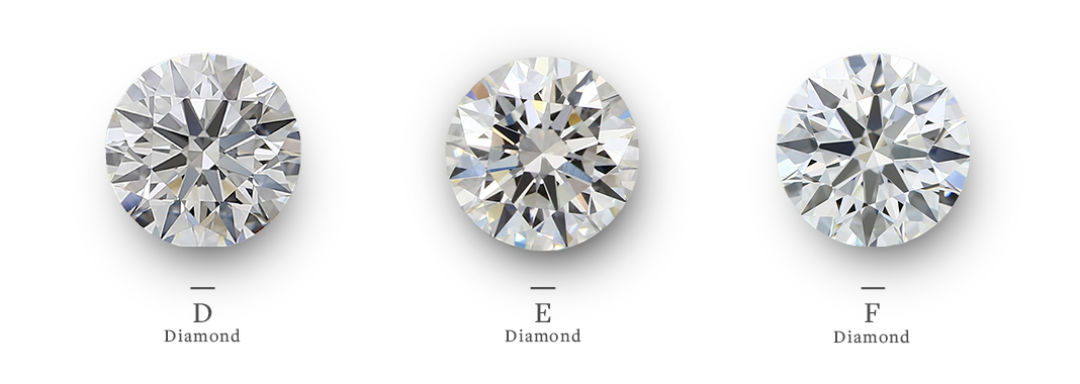Which Diamond Color Is Best? It's Not As Simple As D Color Diamonds

What diamond color is best? If you're going for a traditional "white" diamond, the answer's easy, right? After all, white is white is white, no? Not exactly. Diamond color isn't the same as colored diamonds, and even "white" diamonds are graded on a scale. Color is one of the "four C's" (along with cut, clarity and carat), and knowing how the color scale works will help you choose a diamond that perfectly fits your personal taste and priorities — and maybe save some money in the process.
TABLE OF CONTENTS
How Diamond Color Is Graded
Diamonds are graded on a spectrum: D through F diamonds are considered colorless; G through L diamonds are "near colorless;" and diamonds classed M through Z have traces of color.
With Clarity wants you to shop with confidence. That's why we only carry diamonds graded D through L. We just can't stand behind lower color grades because we feel that you don't get an amount of sparkle that will make you smile each and every time you slide the ring on your finger.
Best Diamond Color Based on GIA Standards
That color spectrum was standardized by the Gemological Institute of America. Each diamond comes with a GIA certificate that includes its color grade and other important information like carat size and measurements.
According to that GIA standard, the "best" diamond color is D. (Read more about D color diamonds here). D color diamonds are the equivalent of IF or FL grade diamonds on the clarity scale — they're very rare, and their price definitely reflects that.

However, the "best" diamond color might not be the best one for your budget.
Best Diamond Color Based on Value for Your Money
At With Clarity, we believe in paying for what you can see.
The truth is, the naked eye can't see the difference between several color grades. You're never going to be looking at your engagement ring under grading condition and magnified, and even with specialized gemologist tools, the difference between some grades is barely perceptible. For example: The difference between the D, E and F colors is really quite small. On an electronic colorimeter, the difference in score between D and F would be between 0.00 and 1.49.
And even G color diamonds, the most popular choice for diamond engagement rings, are considered exceptional — they have minor traces of color that can be identified only by diamond professional. Although their technical designation is "near colorless," G color diamonds don't really have a color; they're most accurately described as having a slightly warm cast. You can't really discern a G's subtle warmth unless they're placed side by side with a diamond that is truly colorless (and significantly more expensive).

So the best diamond color for your money is the lowest color grade that looks white to your eye. Color grades such as G, H and I can be great choices. Plus, there are ways to make stones look whiter — such as pairing a warm stone with a yellow gold or rose gold setting — so it's like getting a higher diamond grade without an accompanying higher price tag.
And if you want a white stone on a budget, it's time you got to know fluorescence. Although there's a persistent rumor going around that fluorescence is always bad, the truth is that it very rarely affects the sparkle of the stone. In fact, diamond fluorescence can also make stones in lower color grades appear one grade whiter. Have more questions? Our expert on-staff gemologists are highly experienced at working with budgets of any size, so they can answer your queries and help you find the specific stone and setting you'll love. Contact one today.
Lab Diamond Color & Certification
A diamond color grade is an important factor when choosing a stone. Depending on the setting, cut, carat, shape, and metal, the color grade can be a discerning factor just as well. Just like natural diamonds, lab grown diamonds too are certified and then graded for color. With an IGI certificate that talks of the four C's, lab grown diamonds are also assessed and graded on the same parameters as earth-mined diamonds. Because they are evaluated on the same parameters, it also means that the differences with regard to their cut, clarity, color, and carat are as good as none. While the color scale from D - Z is available to choose from in a mined as well as a natural diamond, at With Clarity we only use the best quality and the best-colored diamonds, especially for you.
With a lab grown diamond too, the lesser the color, the better the grading it will receive. So while a G color natural diamond and a G color lab grown diamond looks the same and is graded on the same parameters, the only difference lies in the way they were created. Most couples prefer to get a G, H, or I color, which are near colorless. Carefully review the IGI certificate of the lab created diamonds you are interested. Our certified gemologists can also review and share their feedback on the ideal color for your budget. Keep in mind that with brilliant cut diamonds, color is better hidden by the facets, whereas with step cut diamonds like the emerald, color is more visible.
As lab diamonds are generally about 30-40% less expensive than natural diamonds, you can always utilize your budget to get a higher color grade than what you initially anticipated getting. At the same time, you can also hold the color grade constant and get a better cut, higher carat or higher clarity. Reach out today if you need more guidance on choosing a color grade for your center diamond.
FAQs
What color are diamonds?
What diamond color is the most expensive?
What is the best color grade for a diamond?
What is the rarest color diamond?









